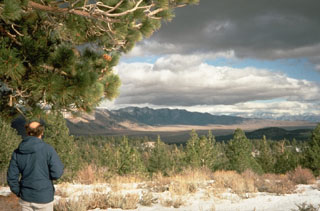Report on Long Valley (United States) — March 1990
Bulletin of the Global Volcanism Network, vol. 15, no. 3 (March 1990)
Managing Editor: Lindsay McClelland.
Long Valley (United States) Continued earthquake swarm in caldera's S moat
Please cite this report as:
Global Volcanism Program, 1990. Report on Long Valley (United States) (McClelland, L., ed.). Bulletin of the Global Volcanism Network, 15:3. Smithsonian Institution. https://doi.org/10.5479/si.GVP.BGVN199003-323822
Long Valley
United States
37.7°N, 118.87°W; summit elev. 3390 m
All times are local (unless otherwise noted)
Earthquake swarm activity in the caldera's S moat continued through March. A swarm of >300 events of magnitude greater than or equal to 2.8 occurred 3 March, followed by smaller swarms on 9, 18, 28, and 30 March. The swarm on the 30th included more than 100 events, all of which were smaller than M 2. Only a few isolated events occurred beneath Mammoth Mountain. Two-color geodimeter measurements indicate that extension across the S moat and resurgent dome continued through March at the 5 ppm/year rate that began in late September.
Geological Summary. The large 17 x 32 km Long Valley caldera east of the central Sierra Nevada Range formed as a result of the voluminous Bishop Tuff eruption about 760,000 years ago. Resurgent doming in the central part of the caldera occurred shortly afterwards, followed by rhyolitic eruptions from the caldera moat and the eruption of rhyodacite from outer ring fracture vents, ending about 50,000 years ago. During early resurgent doming the caldera was filled with a large lake that left strandlines on the caldera walls and the resurgent dome island; the lake eventually drained through the Owens River Gorge. The caldera remains thermally active, with many hot springs and fumaroles, and has had significant deformation, seismicity, and other unrest in recent years. The late-Pleistocene to Holocene Inyo Craters cut the NW topographic rim of the caldera, and along with Mammoth Mountain on the SW topographic rim, are west of the structural caldera and are chemically and tectonically distinct from the Long Valley magmatic system.
Information Contacts: D. Hill, USGS Menlo Park.

